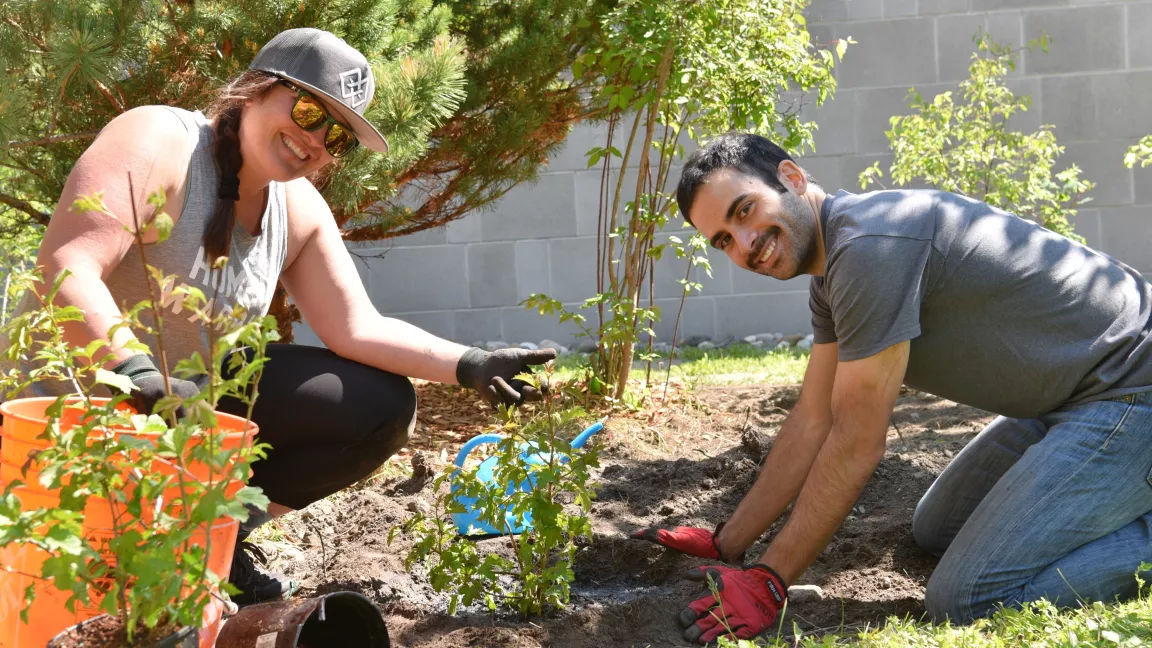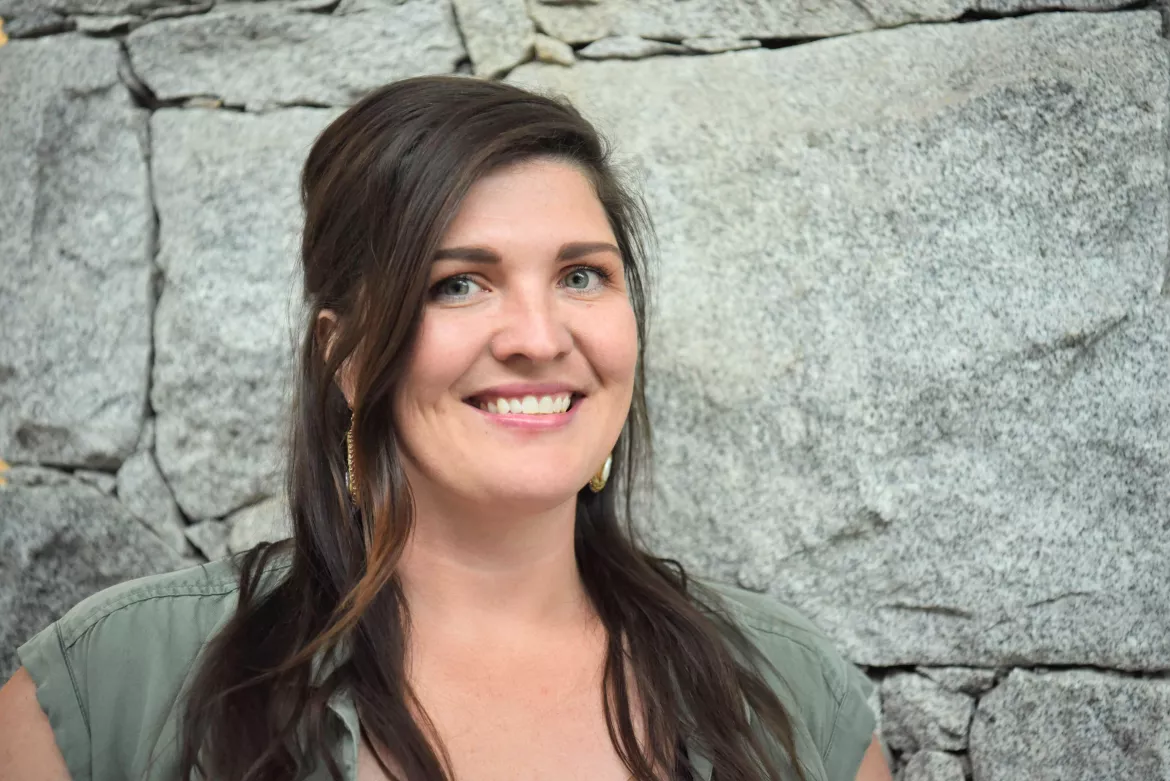A space to connect and grow
The Wabooz garden has undergone an inviting transformation this summer as phase one of the First Nations Centre's revitalization plan nears completion. UNBC student Sarah McLaughlin credits tremendous support from Facilities staff for helping with her efforts to lay a foundation that will allow the garden to bloom and grow in the years to come.

A unique outdoor space nestled in the heart of UNBC’s Prince George campus is gaining a new lease on life.
With support from many departments, the First Nations Centre has committed to revitalizing the Wabooz Garden to provide a welcoming, educational green space that connects Indigenous Peoples, students, faculty and staff, as well as local residents.
The FNC’s hope is to create a garden representative of northern biology, holistic medicine, Indigenous history and Reconciliation. Phase one of the project has taken root this summer.
Situated in an open courtyard outside the First Nations Centre and visible from the Bentley Centre corridor, the garden was originally developed as part of a research project into sustainable landscaping led by Dr. Annie Booth in 2005. Wabooz means ‘rabbit’ in the Anishinaabe language and the garden was named in honour of Perry Shawana, former Chair of the First Nations Studies Program. The space did provide refuge for a family of deer for several seasons before slipping into a period of fallow.
“It’s important not just for sustainability, but for being a bit of an ‘oasis of plantings’, a natural space for people to be in,” says Booth, an Environmental and Sustainability Studies Professor. “It attracts a lot of wildlife and is not just lawn. Instructors use it for teaching, so it’s an important place to keep.”
One of those instructors is Ecosystem Science and Management Assistant Professor Dr. Lisa Wood, who used the garden’s planned rejuvenation as an opportunity for experiential learning for students in her Biology 350 Ethnobotany class this past winter.
The students were divided into smaller groups and asked to research which plants they thought might be good candidates for the garden based on a number of considerations including importance to the local area, cultural relevance, growing conditions and maintenance requirements. They were also asked to propose some level of creative knowledge transfer that would allow for interaction between the proposed plants and the University community.
After much investigation and the addition of parameters like cost and space allocation over the course of the semester, the students presented their proposals to the planning committee for the garden.
“It was fun for most students because it was a real-life situation where they could actually apply some of what they’ve been learning to a situation that’s meaningful for the community that exists for them now,” says Wood. “The parts that really impressed me were some of the groups really embraced the aspect of culture and connection to the community at the University: some of them had opening ceremonies that they proposed for unveiling this type of space; some of them integrated art projects into the space; some of them were thinking about what types of plants would be used by wildlife and how to entice more wildlife into the space, like insects and pollinators and the deer that have already been there.”

The summer student hired to complete phase one of the garden revitalization project says she applied for the position, in part, to feel more connected to this territory.
“I do plan on staying in northern B.C. once I’m done my degree,” says Sarah McLaughlin, who will be entering the 4th year of her Bachelor of Planning degree with a major in First Nations Environmental Planning.
“In order to be a well-rounded planner working with local communities, I feel having an understanding of their plants and a respect for those plants and the abundance of the benefits we gain from the natural world is crucial. It’s helping me find my sense of place in northern B.C.”
McLaughlin met with Wood in late spring to discuss the plants proposed by the ethnobotany students. She spent time testing the soil pH and nitrogen levels and paid attention to the garden’s sun exposure.
“I’m trying to get these garden beds prepared for long-term success, not just trying to get plants in the ground as soon as possible,” says McLaughlin. “We want plants that are indigenous to the region and plants that are going to thrive here.”
Booth notes there was strong resistance from some corners of the University to the original idea of the garden.
“Some at UNBC did not see the point at the time, although many do now. Sometimes you have to persist,” she says.
Booth believes the space is critical to the University community and she says it’s wonderful to see the First Nations Centre breathe new life into the untended area.
For Wood, the garden’s importance stems from its unique indoor-outdoor accessibility. “Even if you’re not inside the garden, if you’re walking through the glass hallway of the Bentley Centre, you feel like you’re part of it,” she says. “We have a plethora of outdoor space on campus -which we’re really lucky to have - but this is one of those more manicured spaces that I think some students would find easier to use if they’re not familiar with trudging through the forest.”
Wood will help McLaughlin identify and collect some of the desired Indigenous plants growing near campus once flowering ends later this month. And McLaughlin has also connected with researchers at UNBC’s Aleza Lake Forest Research Centre to source out plants like wild ginger and Labrador tea.
The future planner has gone beyond the scope of this summer’s initial phase to look at laying the foundation for an interpretive garden, creating signage that will offer both scientific information and Indigenous knowledge of the plants. She points to tremendous support from Facilities staff with helping her accomplish this summer’s objectives.
McLaughlin says she’s also considering asking permission to do an independent study to formally map out what’s been done to date and suggest future plantings to ensure the garden will bloom and grow for years to come.
“The garden is an educational piece and staff at the First Nations Centre are just hoping to welcome more people to the space, rather than it being an area people are unsure whether to enter,” says McLaughlin. “The hope is to just invite people outdoors.”